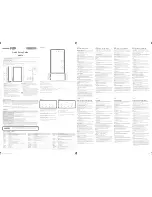
No product better exemplifies the fundamental shift in
home-entertainment technology than the controller. Also
known as a surround-sound processor or audio-video pre-
amplifier, the controller is an entirely new
product category that combines many
diverse functions in a single chassis. To
understand what a controller is and does is to
understand the technologies that are trans-
forming the way we reproduce sound in our
homes.
A modern controller replaces as many as
four separate components in your music and
home-theater system: the source-switching
functions of a preamplifier, a surround-sound
decoder, six (or eight) channels of digital-to-
analog conversion, and an electronic
crossover to split up the frequency spectrum.
Moreover, the rapidly increasing computer horsepower in
today’s controllers points to a future in which they will
incorporate even more func-
tions and capabilities, such as
digital signal processing for
loudspeaker and room cor-
rection. While power amp-
lifiers
and
loudspeakers
change relatively little over
time, the controller repre-
sents a radical new path to
the future.
Despite the power and
sophistication of some of
t o d a y ’s controllers, they are
remarkably inexpensive and
relatively easy to use. While
none of us would call a $5,000
audio product cheap, the price
of a High End controller is rea-
sonable considering all the
functions it performs. In addition, it seamlessly merges a
diverse array of sophisticated processing and controls to pro-
vide nearly transparent inter-operability to the user. Still,
designers need to focus on improving the user interface so
that anyone can operate even the most sophisticated system.
As controllers replace two-channel analog preampli-
fiers, many of us music purists are concerned that two-chan-
nel music reproduction may be compromised in the rush to
add features. Some controllers are designed with an empha-
sis on multi-channel film-soundtrack repro-
duction, with little regard for the two-chan-
nel musical experience. Other controllers can be considered
true High End preamplifiers that also offer surround-sound
decoding and video switching. This diversity of products on
the market lets you choose a controller that
parallels your priorities. The movie buff will
have very different requirements from the
music listener who wants a little surround
sound when he occasionally watches a
movie.
Inputs, Outputs, and Source
Switching
Let’s start with the controller’s most basic
function, selecting the source you listen to or
watch. The controller accepts audio or A/V
(audio and video) signals from all your
source components and lets you select which
source signal is sent to the power amplifiers and video mon-
itor. A basic controller will offer two analog-audio inputs
(for a tuner and CD player, for
example) and perhaps four
audio-video (A/V) inputs. In
addition to the main outputs
that drive your TV and power
amplifiers, two record outputs
are often provided to drive
two VCRs or a VCR and an
analog tape recorder.
When choosing a con-
troller, make sure its array of
inputs matches or exceeds the
number of source compo-
nents in your system. Yo u r
system is likely to expand in
the future, so look for a con-
troller with at least two more
inputs than you need right
now.
All controllers have inputs for digital audio signals as
well as for analog. These inputs receive the digital-audio
output of a DVD player, laserdisc machine, DSS receiver, or
CD transport. The signals carried on these digital connec-
tions include Dolby Digital, DTS, Dolby Surround, and two-
channel PCM (Pulse Code Modulation) signals, such as from
a CD transport.
If you’re an old hand at home theater, you proba-
bly own a laserdisc player with Dolby Digital output. Fur-
ther, you know that to get Dolby Digital
(once called AC-3) onto a laserdisc, the sig-
R O B E R T H A R L E Y
Controllers
. . . . . . . . .
A modern controller replaces
as many as four components
in your music and home-the-
ater system: the source-
switching functions of a pre-
amplifier, a surround-sound
decoder, six (or eight) chan-
nels of digital-to-analog con-
version, and an electronic
crossover to split up the
frequency spectrum.
















































